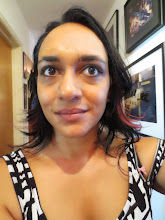East of the West features 16 artists from around the Bay Area, all of whom come from the region we generically call "the Middle East," but few of whom make art that we would typically relate to our conventions surrounding that part of the world. The artists, who range in age, approaches and length of time spent in the US, have origins in Iran, Egypt, Lebanon, Israel and Iraq.
The exhibition is sponsored by the Asian Pacific Islander Cultural Center, whose 11th Annual United States of Asian America Festival opened concurrently with our show. The festival features exhibitions, performances, screenings and readings taking place all over San Francisco, throughout May.
Artists in East of the West include Taha Belal, Youmna Chlala, Ali Dadgar, Dina Danish, Osama Dawod, Ala Ebtekar, Amir Esfahani, Mitra Fabian, Taraneh Hemami, Hiba Kalache, Bessma Khalaf, Nazanin Shenasa, Hadi Tabatabai, Nomi Talisman, Taravat Talepasand and Shadi Yousefian.
We'll have a panel discussion at the gallery on Wednesday, May 14, from 7-9 PM, co-sponsored by APICC and the San Francisco Arts Commission Gallery, in conjunction with our show and After the Revolution at San Francisco City Hall. The panel, moderated by Berin Golonu, Associate Curator at Yerba Buena Center for the Arts, will feature artists Youmna Chlala (East of the West) and Naciem Nikkah (After the Revolution), critic Soraya Murray and historian Maziar Behrooz.
We'll also have a satellite exhibition opening at Supervisor Ross Mirkarimi's office in City Hall on Friday, May 16. Scroll down for details.
Our curatorial statement follows, and pictures of the installation can be found by clicking the image below.
Amir Esfahani, Step Back (detail), 2008
Photo by Stephan Vladimir Bugaj
How can we begin to understand a region as diverse and far-ranging as the Middle East? We are constantly exposed to simplified images depicting this part of the world as rife with conflict, intolerance, religious fundamentalism and cruelty toward women and minorities. While certainly these strains exist, for the most part life goes on, as it does everywhere. Art is made, jokes are told, people are born, grow up, fall in love and get old.
When we were invited to do this show, we were initially hesitant. What purpose is there in creating another Middle East show, in inviting artists to show together based on their geographic origin rather than the ideas with which they engage or the methods they use to do so? Artists we approached expressed similar concerns: a resistance to being categorized and consequently marginalized, a reluctance to be seen as a “Middle Eastern artist.” However, we all agreed on the need to promote more diverse images of this part of the world, and so the show came to life.
The work takes three distinct threads. First is a dialogue with modern and contemporary art history as defined by Europe and the United States. The artists herein have studied and absorbed these precedents, and their responses are further informed by a parallel politics of the image, specific to the Muslim world, in which abstraction is a spiritual practice and word is image. Representation, personal appearance and control of the gaze reverberate differently within these two cultural perspectives.
Second is a questioning of cultures. As immigrants, we live between the old world and the new. Shaped by tradition, we embrace the freedom to choose our future paths while being acutely aware of expectations and strictures on all sides. We are insiders and outsiders in both worlds, attuned to the advantages and shortcomings of both ways of thinking, and knowing we will never be fully accepted by either.
¬¬
Third is a critique, often laced with humor, of the media’s one-dimensional portrayal of the Middle East. These tropes—fundamentalism, restriction of women, war and conflict, oppressive regimes, terrorism—are turned on end. Affronted by superficial assumptions, yet deeply aware of the real troubles that underlie them, we are caught between laughing and crying. We choose laughter and action over tears and disaffection.
Finally, we ask, East of what? West of whom? From where we stand—in California, the westernmost point in the Western world—the East is the West. Western Europe and the Middle East are much closer to each other than either is to us. From this point on our global sphere, we can see a new perspective. We adopt a new identity that is both East and West.
East of the West
SomArts Cultural Center Bay Gallery
934 Brannan Street, San Francisco
May 1 - 24, 2008
Hours: Tues-Fri 2-7PM, Sat 1-5PM
Extension: East of the West
Supervisor Ross Mirkarimi's Office, San Francisco City Hall
1 Dr. Carlton B. Goodlett Place, Room 244
Opening Reception: Fri, May 16, 5:00-8:00 pm
May 16 - June 17, 2008

No comments:
Post a Comment